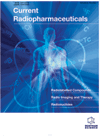- Home
- A-Z Publications
- Current Radiopharmaceuticals
- Previous Issues
- Volume 14, Issue 3, 2021
Current Radiopharmaceuticals - Volume 14, Issue 3, 2021
Volume 14, Issue 3, 2021
-
-
Emerging Molecular Targets for Imaging of Atherosclerotic Plaque using Positron Emission Tomography
More LessAuthors: Rudolf A. Werner, Frank M. Bengel and Thorsten DerlinPositron-emission-tomography (PET) using the radiopharmaceutical 18F-fluorodeoxyglucose (FDG) has become an established and validated molecular imaging modality for characterization of the inflammatory activity of atherosclerotic plaque. In the latest years, new innovative radiopharmaceuticals and applications have emerged, providing specific information on atherosclerotic plaque biology, particularly focu Read More
-
-
-
Nuclear Imaging of Post-infarction Inflammation in Ischemic Cardiac Diseases - New Radiotracers for Potential Clinical Applications
More LessAcute myocardial infarction is one of the leading causes of death in the western world. Despite major improvements in myocardial reperfusion with sophisticated percutaneous coronary intervention technologies and new antithrombotic agents, there is still no effective therapy for preventing post- infarction myocardial injury and remodeling. Death of cardiomyocytes following ischemia results in “danger signals” that elicit an i Read More
-
-
-
Artificial Neural Networks in Cardiovascular Diseases and its Potential for Clinical Application in Molecular Imaging
More LessIn medical imaging, Artificial Intelligence is described as the ability of a system to properly interpret and learn from external data, acquiring knowledge to achieve specific goals and tasks through flexible adaptation. The number of possible applications of Artificial Intelligence is also huge in clinical medicine and cardiovascular diseases. To describe for the first time in literature, the main results of articles about Artificial Int Read More
-
-
-
Novel PET Tracers in the Management of Cardiac Sarcoidosis
More LessSarcoidosis is a systemic inflammatory disease of unknown etiology, pathologically characterized by non-caseating granulomas involving several organs and tissues. This pathological process can eventually affect the heart during his course leading to fibrosis associated with systolic dysfunction, conduction disturbance, and even sudden cardiac death. Due to this prognostic impact, diagnosis is crucial to optimize clini Read More
-
-
-
The Role of Molecular Imaging in the Assessment of Cardiac Amyloidosis: State-of-the-Art
More LessAuthors: Cristina Popescu and Irene A. BurgerCardiac amyloidosis is a progressive infiltrative disease for which new treatments are now available. As therapy should be started as early as possible to avoid complications such as restrictive cardiomyopathy, arrhythmias and heart failure, a prompt and reliable diagnosis by means of non-invasive tests would be highly warranted. Electrocardiography, echocardiography and cardiac magnetic resonance imaging are all Read More
-
-
-
Single Photon Emission Tomography in the Diagnostic Assessment of Cardiac and Vascular Infectious Diseases
More LessCardiac and vascular infection is an arising cause of mortality and morbidity in the adult population. Diagnosis based on culture and anatomic imaging are frequently inconclusive. Radiolabeled leucocyte scintigraphy plays a useful role in the diagnosis and management of these serious infectious conditions. In this paper, we present an update on the diagnostic performance of single- photon emission tomographic (SPECT Read More
-
-
-
The Role of 18FDG PET/CT in the Assessment of Endocarditis, Myocarditis and Pericarditis
More LessAuthors: Assuero Giorgetti, Dario Genovesi and Michele EmdinEndocarditis, myocarditis and pericarditis are a heterogeneous group of phenotypic syndromes where the culprit area of inflammation is the heart. Inflammation may be determined by an infective agent, toxins, drugs or an activated immune system. Clinical manifestations can be subtle and diagnosis remains a challenge for cardiologists, requiring high level of suspicion and advanced multimodal cardiac imaging to avoid life-t Read More
-
-
-
New Therapies to Modulate Post-Infarction Inflammatory Alterations in the Myocardium: State of the Art and Forthcoming Applications
More LessAuthors: Olivier F. Clerc, Philip Haaf, Ronny R Buechel, Oliver Gaemperli and Michael J. ZellwegerAcute myocardial infarction (AMI) is a major cause of morbidity and mortality worldwide. AMI causes necrosis of cardiac cells and triggers a complex inflammatory response, affecting infarct size, cardiac function and clinical outcomes. This inflammatory response can be divided into 3 phases: 1) the pro-inflammatory phase, in which the release of damage-associated molecular patterns from necrotic cells triggers the s Read More
-
Volumes & issues
Most Read This Month
Article
content/journals/crp
Journal
10
5
false
en


